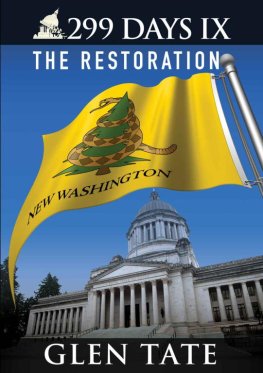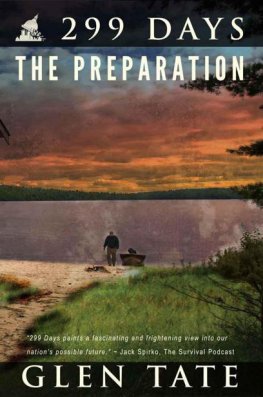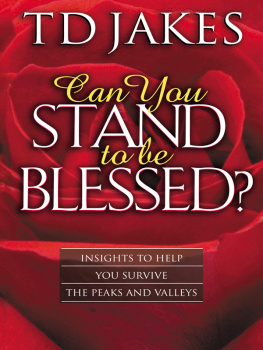299 Days
THE COLLAPSE
by
Glen Tate
To my real wife: I hope this book turns out to be fiction. I suspect it won't, but I'd love to be wrong. But in the meantime, I'm a man, and a man takes care of his family. I did. I will forever be proud of that, even if I wasn't understood at the time.
Glen Tate has a front row seat to the corruption in government and writes the 299 Days series from his first-hand observations of why a collapse is coming and predictions on how it will unfold. Much like the main character in the series, Grant Matson, the author grew up in a rural and remote part of Washington State. He is now a forty-something resident of Olympia, Washington, and is a very active prepper. Glen keeps his real identity a secret so he wont lose his job because, in his line of work, being a prepper and questioning the motives of the government is not appreciated.
- Book 2 -
Chapter 43
May Day
Grant had been so absorbed by Washington States spiral into collapse that he did not pay much attention to the coinciding national collapse. The Federal Government was in the same shape as Washington State, and for the same reasons. He was so consumed by what was happening in Washington State, but managed to pick up on some of the major details surrounding the collapse across the nation.
The Federal Government ran out of money. Tax revenue was only paying about half of the money the Federal Government was spending each year. The Government had to borrow the other half. Interest on the debt was going up each year. Pretty soon, about half of the budget would go to paying off interest, which meant the government needed to borrow even more to pay the interest. Borrowing to pay for borrowing. The United States of America was in a financial death spiral. Anyone who paid attention could see this.
Most average Americans werent paying attention; they knew the government was spending too much, but didnt really know the details. However, the foreign governments, especially China, who loaned the U.S. all the money, were paying attention. They knew that they were never going to get their money back. They had to cut their losses.
The second lowering of the U.S. bond rating a few months ago had been a shock to the financial system. Not a surprise, but still a shock. People in the financial markets had wondered why it took this long for the unsustainable debt of the U.S. to catch up with reality. For the first few days after the bond rating was lowered, no large holder of U.S. bonds wanted to be the first to sell off their bonds. That would lower the value of their remaining holdings. Small holders of U.S. bonds, like mutual funds and wealthy individuals, were selling, but the price wasnt dropping as fast as Grant had thought it would.
The bonds were basically shares of stock in the strength of the U.S. dollar, so when they went down, the value of the U.S. dollar went down. Slowly at first; inflation never occurs overnight. The government kept telling everyone that inflation wasnt going to go up, so people continued believing everything would be fine.
Then it happened. It was May Day. On that day, which was full of symbolism to the Communists, China started selling its U.S. bonds. The May Day Dump, as it became known. Japan, Europe, and the Middle East followed in a mad dash to dump the dollar. The value of the U.S. dollar plummeted. U.S. bonds were being bought up by unknown investors, but everyone assumed it was the Federal Reserve buying through third parties. The Federal Reserve paid for these bonds with money it created electronically and sent to the U.S. Treasury. They paid for debt with fake money. That money could not be valuable anymore. People had lost faith in the value of the dollar. Dollars were only paper, so once the faith was gone, the value was gone.
Inflation started. It was not bad at first; but went up steadily. Interest rates went up substantially because the dollars loaned would be paid back in the future with dollars that were much less valuable now. The Federal Reserve had always tried to keep interest rates near zero to spur loans and spending. It couldnt keep rates artificially low, anymore. So, overnight, the Federal Reserve massively raised interest rates. Since the American economy ran on people buying things they couldnt afford with credit, when interest rates shot up, people really couldnt buy things.
The stock market crashed. Again. It had never really recovered from the first crash when the U.S. bond rating was lowered previously. Unemployment went through the roof; it hit 25% in about one week. America was in a full economic depression. Except, unlike the Great Depression of the 1930s, this depression had high inflation. It was the worst of both worlds: very little economic activity, but the necessities of life were costing more and more.
Separate regions of the country were affected differently. California and the Northeast had it the worst; they had the largest government per capita. This meant more dependency and the biggest shock and outcry when the government checks stopped. It also meant people were less self-sufficient. They owned fewer guns to protect themselves.
The Midwest was a mixed bag. Illinois was an absolute wreck. The big cities in the Midwest were like California and the Northeast, but the rural areas were doing better. Not great, but better.
Washington State fit the Midwest model. In the Seattle metro area, which included Olympia, government was huge and people were, for the most part, dependent.
However, in the rural areas of the state, which included Pierce Point where Grants cabin was, things were better. People were less dependent on government, and a higher percentage of them were more self-sufficient. Gun ownership was high. Things still sucked there, but the situation wasnt as desperate as in the Seattle area.
Some states were faring much better. Texas and the Southern states, along with Arizona and the Mountain West, were doing better because they had semi-functional state and local governments. They had many self-sufficient people. Entrepreneurs and people who wanted to be free had left states like California and settled in those states.
Texas was still dealing with the Mexican refugee problem, though it was winding down. The drug lords had killed so many of each other that they were petering out. They were weak compared to what was left of the Mexican government. Some Mexicans were actually returning to Mexico because they found gangs and violence and starvation up in America.
It was still bad in Texas; Bill Owens would explain to Grant in their phone calls and texts, but they were getting it under control. Grant quit watching the news because the reporting was so biased that it wasnt worth watching. He got his news from Bill Owens.
Texas didnt have to enact any draconian measures like martial law. For the most part, neighbors were cooperating and the local police and the Texas State Guard was handling things well. The Texas Governor changed the name from the Texas National Guard to the Texas State Guard to emphasize its allegiance to the citizens of the state, not the Federal Government. People were fighting back against the Mexican and other gangs that surged at the beginning of the crisis. Arizona was in a similar situation.
California was a basket case. Gangs ran wild. White gangs, black gangs, Mexican gangs, Asian gangs. Gang was one of those words that had a different meaning pre-Collapse. Back then, it only meant a scary street gang, like Hells Angels or the Crips. While there was still plenty of that, after the Collapse, a gang didnt necessarily mean scary people. It meant a neighborhood banding together, cops who administered street justice to deserving bad guys, or a group of soldiers or cops who had been laid off and got together. Some gangs were even formed at office buildings among people who sat in cubicles together and needed to protect themselves.













